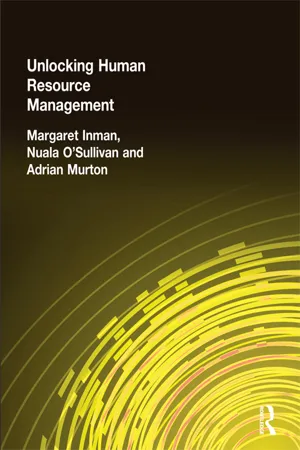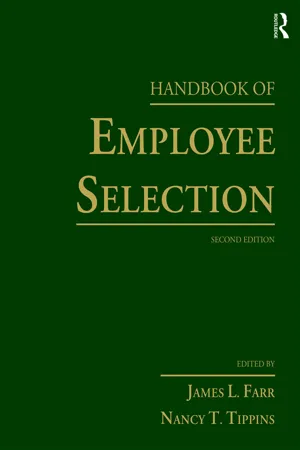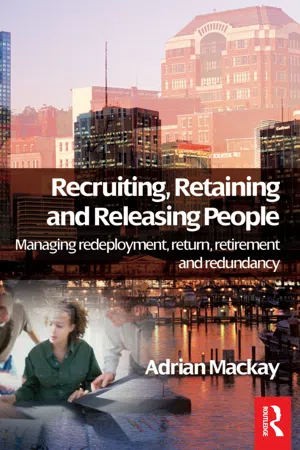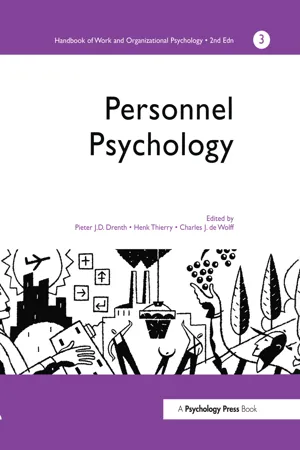Business
Initial Selection Process
The initial selection process involves identifying and evaluating potential candidates for a job or position within a company. This typically includes reviewing resumes, conducting initial interviews, and assessing basic qualifications and skills. The goal is to narrow down the pool of applicants to a smaller group of individuals who will proceed to the next stage of the hiring process.
Written by Perlego with AI-assistance
Related key terms
Related key terms
1 of 4
Related key terms
1 of 3
5 Key excerpts on "Initial Selection Process"
- eBook - ePub
- Margaret Inman(Author)
- 2014(Publication Date)
- Routledge(Publisher)
• This is a two-stage process. The first stage involves analysing the job that is available and producing either an accurate job description and person specification or an accountability profile for the job. Care needs to be taken so as not to include any requirements which may be considered discriminatory.• The second stage is using an appropriate method to advertise the vacancy. The CIPD (2009) survey suggests the majority of organisations today use their own corporate website, recruitment agencies and local papers to advertise.The selection process• Selection is the part of the process which involves choosing between applicants.• There are two stages to the selection process. The first is screening candidates to eliminate those who are totally unsuitable for the job vacancy; the second is applying a variety of selection methods to try and accurately predict who would be the best candidate for the job.• Selection should be a two-way process. It should allow for the candidate to select themselves in or out of the process as well as for organisation selection purposes.Screening• - eBook - ePub
People Practice
A Complete Guide
- Karen Waite, Kathy Beevers, Nicky Small, Keith Tomlinson, Shazad Hussain(Authors)
- 2021(Publication Date)
- CIPD - Kogan Page(Publisher)
Once recruitment has taken place and a suitable number of applications have been received, the next step is to start selection. While recruitment is about attracting candidates to apply for a position with the organisation, selection is the process of choosing a candidate to make an offer of employment from the range of candidates who have applied for the role. Making effective selection decisions is crucial in achieving organisational performance. The cost of selection is often significant with CIPD (2020a) reporting the median cost per hire of £5,000 for senior managers and directors, decreasing to a median cost per hire of £2,000 for other employees. Although the reported cost per hire includes recruitment and selection activities, it is nonetheless a significant sum of money. Spent wisely, this money could ensure that highly suitable candidates are appointed who can contribute to organisational performance. On the other hand, if poor selection decisions are made, organisations may have to manage poor performance, have unnecessary employee turnover, and continue the cycle of recruiting and selecting with its associated costs.Reviewing applications
A successful application typically goes through several selection stages before a job offer is made. An effective selection process allows applications to be assessed against the selection criteria for the role; at each selection stage, some applications are rejected until the successful candidate is found. The first stage is to review the applications against the criteria set out in the person specification or role profile. The essential and desirable criteria were established at the recruitment stage and comparing individual applicant’s details to these objective criteria helps to ensure that valid and reliable decisions are made. Importantly, applicants are compared to the essential and desirable criteria rather than compared to each other. This part of the selection process is known as sifting and is a common selection method: CIPD (2020a) report 78 per cent of organisations screen CVs or applications.Sifting
Sifting can take place manually, where a person reviews each application, or by using software designed for this purpose. If software is used, it is important that key words or key search criteria are accurate to avoid the risk of suitable candidates being rejected before their application is viewed by a person. Sifting by software can overcome human error and, providing the correct criteria have been identified, the software can make consistent decisions about which applications to progress and which to reject. Alternatively, a person sifting applications might make mistakes or be biased, potentially rejecting suitable applicants. Both options have a resource implication, and large organisations that have high recruitment and selection activity may prefer to invest in resourcing software that sifts applications, as the frequency of use can yield a return on their investment in the software. - eBook - ePub
- James L. Farr, Nancy T. Tippins, James L. Farr, Nancy T. Tippins(Authors)
- 2017(Publication Date)
- Routledge(Publisher)
Industrial and organizational (I-O) psychologists have played major roles in developing selection (or staffing) tools and implementing selection programs at every level for organizations of every size and in every industry, domestic and multinational. This chapter focuses on evaluating, monitoring, and managing the business value of employee selection. We begin by offering some general comments about the traditional model of employee selection, or staffing, its focus, and its components, with particular emphasis on selection as a dynamic organizational process, the expectations of multiple stakeholders, and the need to link employee-selection goals to business imperatives. Following that discussion, we present a decision-based framework that illustrates the logic of employee selection, with particular emphasis on assessing the outcomes of selection efforts. Such outcomes may be expressed in qualitative or quantitative terms, and we illustrate both. A key focus of the chapter is to use evaluation strategically to drive effective selection programs. We then consider what managers know about employee selection, the different perspectives of I-O psychologists and managers, and what both groups should know about the value of employee selection, including technology-enhanced assessments and multimedia, immersive simulations. We conclude with a set of recommendations for managing and monitoring the business value of employee selection, including tradeoffs among managerial concerns for “better, faster, cheaper, with less adverse impact.”Traditional Model of Employee Selection
I-O psychologists have developed a general approach to employee selection that has evolved over many decades (Cascio & Aguinis, 2011). Essentially, it consists of defining the work to be done, identifying individual-level characteristics that are hypothesized to predict performance with respect to the work to be done, and developing measurement instruments to assess the relative standing of job applicants on each of the individual-level characteristics (Binning & Barrett, 1989). Then applicants are rank-ordered based on their relative standing, and those with the best scores are selected for the job. - eBook - ePub
- Adrian Mackay(Author)
- 2010(Publication Date)
- Routledge(Publisher)
6. Advertise the duties and responsibilities of the post in the appropriate media (remember internal candidates), giving clear instructions on how to apply and the closing date. Indicate salary range or type of salary, and other remuneration options.7. Receive all the applications and decide how you will formulate your interview shortlist. Inform those people on the shortlist of arrangements for interviews and thank those who applied but have not been short-listed.8. Go into the preparation stage of the interview process for each interview conducted. 9. Offer feedback to those candidates who would like it, to help them learn from the process. 10. After all the interviews have been completed, decide which candidate has been most successful and those who were not selected. Inform them all of your decisions.It will be important to decide who in the organisation makes the candidate evaluation and selection decision. In larger organisations both operating managers and personnel specialists are involved in the process, and it is a general rule that if more than one person is involved, more effective candidate evaluation and selection decisions are made. Box 1.4 gives an outline to the job selection process and Table 1.3 illustrates the respective roles of operating managers and personnel managers in the scheme.Person specifications as outlined above (pages 35–7) will be necessary for any effective evaluation/selection programme and these must be stated explicitly in the job specification.Profile analysis
Unfortunately, there are no scientific formulae for defining position requirements and evaluating job applicants. The position/person match process seems more art than science and, while it is performed daily by managers, few feel comfortable with the required complexities. (Those that do are often insensitive to the suggestion that they could possibly be at fault when they have ‘been in this game as long as I have’). One reason is that there is no analytical framework in place to address the process of balancing people with jobs. - eBook - ePub
A Handbook of Work and Organizational Psychology
Volume 3: Personnel Psychology
- De Charles, P J D Drenth, THIERRY HENK(Authors)
- 2013(Publication Date)
- Psychology Press(Publisher)
If it is decided to fill the vacancy then the question arises as to how to go about it in the best possible way. The labour market is dispersed and consists of niche markets. Candidates within or outside the organization, people working part-time or full-time, or employees with a temporary or permanent appointment may all be eligible. Preference can be given to special categories such as the long-term unemployed, women, foreigners, the handicapped, and so on. In addition, an important step is the way in which applicants are searched for: by means of advertisements, “head-hunters”, the job centre, the temps agency, and so on.Decisions such as these have a bearing on the extent and quality of the group of applicants. Furthermore, not only suitability considerations play a role, for instance, the government, the unions or the works council may stimulate extra opportunities for certain categories of employees (“positive discrimination”). Sometimes, the government provides subsidies for the appointment of certain categories of employees (e.g. the long-term unemployed).That which follows the selection process deserves attention as well. The decision to employ someone is in most cases the beginning of a long-lasting cooperation between the organization and the individual, and for the employee the beginning of a career. Many organizations used to offer lifelong employment. Lately this has changed since, due to global competition, organizations strive for flexibility. But even so in many cases there will still be a long lasting relationship.The intensive interaction during the selection process between the supervisor and the personnel officers on the one hand and the applicant on the other may be seen as the beginning of a socialization process. The applicant gets an idea of what they may expect of working in the organization and what expectations the company has regarding their contribution. Likewise, the organization tries to form an opinion of what it can expect of the applicant when appointed. This interaction is based on more than just personal characteristics.
Index pages curate the most relevant extracts from our library of academic textbooks. They’ve been created using an in-house natural language model (NLM), each adding context and meaning to key research topics.
Explore more topic indexes
Explore more topic indexes
1 of 6
Explore more topic indexes
1 of 4




